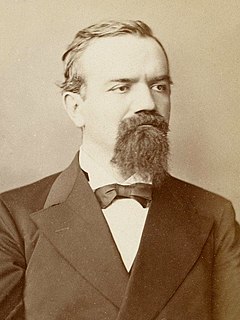
Julius Johannes Ludovicus Ritter von Payer, ennobled Ritter von Payer in 1876, was an officer of the Austro-Hungarian Army, mountaineer, arctic explorer, cartographer, painter, and professor at the Theresian Military Academy. He is chiefly known for the Austro-Hungarian North Pole expedition in 1872–74 and the discovery of Franz Josef Land.
An academy is an institution of secondary or tertiary higher learning, research, or honorary membership. The name traces back to Plato's school of philosophy, founded approximately 385 BC at Akademia, a sanctuary of Athena, the goddess of wisdom and skill, north of Athens, Greece.
Leutnant is the lowest Lieutenant officer rank in the armed forces of Germany (Bundeswehr), Austrian Armed Forces, and military of Switzerland.

Titu Liviu Maiorescu was a Romanian literary critic and politician, founder of the Junimea Society. As a literary critic, he was instrumental in the development of Romanian culture in the second half of the 19th century.
A secondary school describes an institution that provides secondary education and also usually includes the building where this takes place. Some secondary schools provide both lower secondary education and upper secondary education i.e. levels 2 and 3 of the ISCED scale, but these can also be provided in separate schools, as in the American middle and high school system. In the UK, elite public schools typically admit pupils between the ages of 13 and 18. UK state schools accommodate pupils between the ages of 11 to 18.
Knight academies were first established in Western European states in the late 16th century. They prepared aristocratic youth for state and military service. It added to the hitherto rudimentary education of the aristocratic youth natural science, statesmanship and languages. Later many converted to humanistic high schools.
The Theresian Military Academy is a military academy in Austria, where the Austrian Armed Forces train their officers. Founded in 1751, the academy is located in the castle of Wiener Neustadt in Lower Austria.

Letters to a Young Poet is a collection of ten letters written by Bohemian-Austrian poet Rainer Maria Rilke (1875–1926) to Franz Xaver Kappus (1883–1966), a 19-year-old officer cadet at the Theresian Military Academy in Wiener Neustadt. Rilke, the son of an Austrian army officer, had studied at the academy's lower school at Sankt Pölten in the 1890s. Kappus corresponded with the popular poet and author from 1902 to 1908 seeking his advice as to the quality of his poetry, and in deciding between a literary career or a career as an officer in the Austro-Hungarian Army. Kappus compiled and published the letters in 1929—three years after Rilke's death from leukemia.

Benedictine College Preparatory is a private Roman Catholic military high school in Goochland, Virginia. It is owned and operated by the Benedictine Society of Virginia, part of the American-Cassinese Congregation. Benedictine offers education through a private military institute model, which has long been a traditional form of education for young men in Virginia.

Ole Otto Paus, né Ole von Paus, was a Norwegian General, diplomat and NATO official. He was head of the army group in the military intelligence service of the exile Norwegian High Command in London during the Second World War, and thus was one of the founders of the Norwegian Intelligence Service. He served as a military attaché in Stockholm and Helsingfors during the 1950s, and was commander-in-chief in Central Norway from 1964 to 1971. From 1971 to 1974 he was Land Deputy of the Allied Forces Northern Europe, i.e. the Norwegian representative in the NATO military command for Northern Europe. As such he was the highest-ranking Norwegian in the NATO command structure at the time.

Theresianum is a private boarding and day school governed by the laws for public schools in Vienna, Austria. It was founded in 1746 by Empress Maria Theresa of Austria.

A gymnasium, also known as a gym, is a covered location for athletics. The word is derived from the ancient Greek gymnasium. They are commonly found in athletic and fitness centres, and as activity and learning spaces in educational institutions. "Gym" is also slang for "fitness centre", which is often an area for indoor recreation. A gym may be open air as well. A gym is a place with a number of equipments and machines used by the people to do exercises.

The Royal Hungarian Ludovica Defense Academy, shortened to Ludovica or Ludovica Academy, was Hungary's officer cadets training institute prior to 1945. The main edifice of the Academy was erected in 1836 at the Ludovica Garden, in Budapest's centrally located VIIIth district. The building was designed by Mihály Pollack in the classical style.

Marijan Varešanin von Varesch was the governor of Bosnia and Herzegovina from 1909 to 1911.

A One-year volunteer, short EF, was, in a number of national armed forces, a conscript who agreed to pay his own costs for the procurement of equipment, food and clothing, in return for spending a shorter-than-usual term on active military service and the opportunity for promotion to Reserve Officers.
The Theresianum Gymnasium is an all-day secondary and high school located in Mainz, Germany. It was founded in 1927 by the Johannesbund e.V.. The high school is a Catholic school and still sponsored by the Roman Catholic Diocese of Mainz. This does not mean that the school does not accept students with a different religion. Students have the opportunity to achieve the highest academic high school degree, the Abitur after year 12 while they enroll in school for year 5.

The Imperial and Royal Technical Military Academy was a military training facility founded in 1717 for certain officer groups of the Habsburg Monarchy. The location of the academy changed several times in the course of its existence: originally located in Vienna, it was located in Klosterbruck near Znaim from 1851 to 1869, in the Stiftskaserne in Vienna from 1869 to 1904 and finally in Mödling from 1904 to 1918. The Higher Technical Education Institute Mödling emerged from the academy in 1919.

Blasius von Schemua was an Austro-Hungarian general of Slovene descent.











